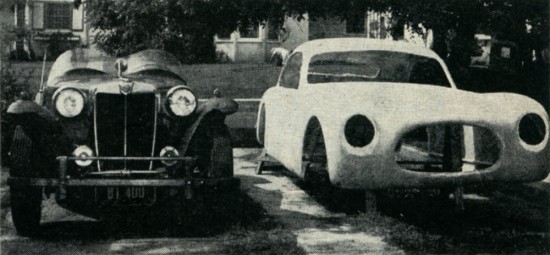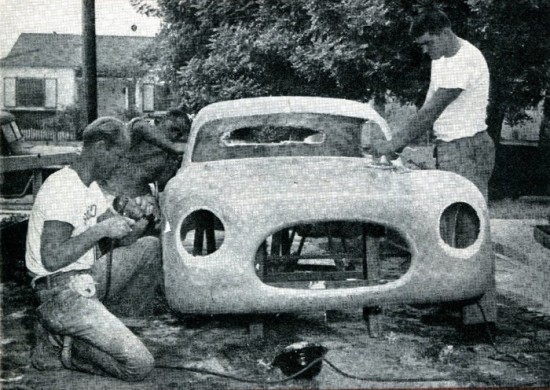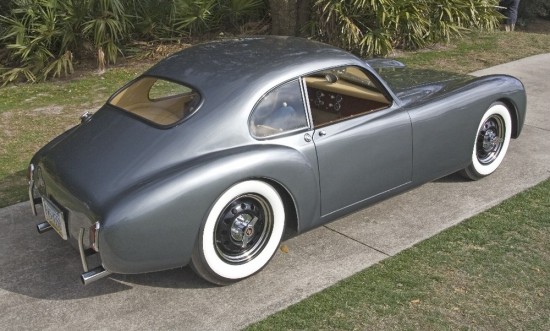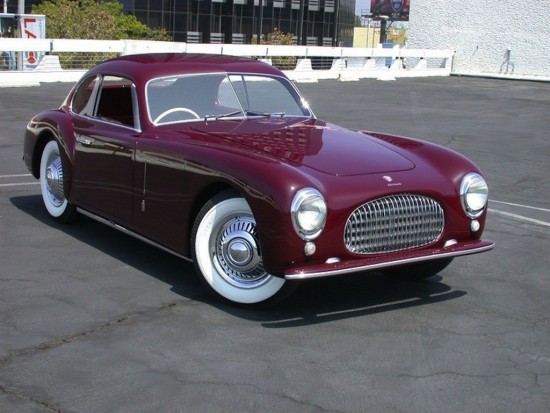by Geoffrey Hacker –
To any gearhead, the names of both Bill Burke and Mickey Thompson are synonymous with speed. Yet they were both also noted innovators, and in the fall of 1952 they collaborated on one of the most beautiful fiberglass sports cars the post-war world had ever seen, the Atlas Swallow.
Burke was into hot rodding back in the late 1930s and thus was heavily involved in the pre-war lakes speed scene. He frequently appeared in Throttle, the first automobile enthusiast magazine published in America, and in the March 1941 issue, Burke is shown in a photograph officially becoming president of the Road Rebels club. He was at the beginning of the hot rodding movement, well before it exploded in the post-war years.
Thompson was also a record setter, but a bit younger than Burke. When Burke was shown in Throttle, Mickey was just 13 years old, but his time would come.
Burke was best known for his introduction of the famed belly tank streamliner at various dry lakes locations in 1946. By the close of the same year, he had already sold his tank to Howard Wilson and Phil Remington, and was working on his next tank, a larger one that would be rear-engined and ultimately named Sweet 16. It would be in this very tank that Burke and friend Don Francisco would be recognized as having built and run the world’s fastest hot rod with a two-way average of 151.085 MPH in July of 1949.
Build it and build it good; Burke and his friends did this each and every time. Throughout his life, if you asked Bill about what he had accomplished, he would always focus on what he was working on, or on his future plans. It’s like that with these guys. They didn’t dwell on the past – they focused on the future.
Fiberglass cars at the Petersen Motorama
Burke’s next major innovation came in 1952. Fiberglass cars had just been introduced as a viable concern for building sports car bodies at the 1951 Petersen Motorama. By the summer of 1952, Burke was building a O-class streamliner – in fiberglass, no less. This may have been the first such streamliner to use this material, and research continues to confirm this streamliner’s place in history.
But Bill Burke also had a day job at that time as advertising manager for Hot Rod magazine. His experience gave him all the content expertise to perform this job at the top of his field. In this capacity, Burke also ran significant parts of Petersen Publishing’s annual Motorama show, which ran from 1950-1955. No rest for the weary, and Burke pressed on. In the fall of 1952, no doubt he would have been working with Roy Kinch when Kinch placed the following ad in Hot Rod magazine advertising his newly formed company, Atlas Fiber-Glass, Inc.
California records show the incorporation date of this company as October 1952, so we have an exact date of when his business began, although like most enterprises that start small, Kinch may have opened up his shop some time earlier. As advertising manager, Burke would have been the one to sign Kinch up for such advertising in Hot Rod, and in this first advertisement, there are some intriguing clues about the plans for this company. Specifically, the ad stated that the company stocked special bodies and tops for MG and would build bodies to customer designs.
No doubt by October 1952, plans on building a body – and probably the process too – were already under way. But what would this body be?
Robert Petersen, publisher of Hot Rod magazine and Bill Burke’s boss, would provide the ultimate answer – and he wouldn’t even know it until years later.
A Cisitalia Is Born
What a year for design 1946 was. It was in this year that the Cisitalia 202 Coupe – one of the most beautifully designed cars to emerge from the immediate post-war era – debuted. From 1947 through 1952 just 170 of these cars were produced. While rare, they were celebrated across the world for presenting a new, modern design for sports cars, one that influenced the body design from the post-war era on.
In 1951, the Museum of Modern Art (MOMA) in New York recognized the Cisitalia as one of the most beautifully designed cars of all time in an exhibition titled 8 Automobiles. MOMA has the following to say about this car, still on display in their museum more than 50 years later:
Designed in 1946 by the Italian car designer and coach builder Pinin Farina (who later changed his name to Pininfarina), the two-seater Cisitalia “202” GT was an aesthetic and technical achievement that transformed post-war automobile body design. Building on aerodynamic studies developed for racing cars, the Cisitalia offers one of the most accomplished examples of coachwork (the automobile’s body) conceived as a single shell. The hood, body, fenders, and headlights are integral to the continuously flowing surface, rather than added on. Before the Cisitalia, the prevailing approach followed by automobile designers when defining a volume and shaping the shell of an automobile was to treat each part of the body as a separate, distinct element – a box to house the passengers, another for the motor, and headlights as appendages. In the Cisitalia, there are no sharp edges. Swellings and depressions maintain the overall flow and unity, creating a sense of speed.
Petersen wanted one of these cars for his upcoming Motorama in November 1952. He found one, bought it, and dispatched Bill Pollack, advertising manager of Auto Speed and Sport, to help bring back what was going to be one of the stars of his show. What an adventure this would be. In fact, Pollack wrote about this very trip in the September 1952 issue of Auto Speed and Sport. It was a humorous recounting of taking a very finicky car across the country at a time when the interstate system we are so fond of today was nowhere to be found. Nor were service stations focusing on the operation of Italian cars. Bill Pollack was one brave soldier to undertake such a journey.
Bill Burke, George Barris and Mickey Thompson copied the Cisitalia 202
When Pollack got the Cisitalia home, Petersen sent it directly to the shop of George and Sam Barris to be put in showroom shape for the November 1952 Petersen Motorama. Of course, Burke knew all of what was going on – it was a small community in Southern California, and all of these guys worked and/or played together. So Burke hatched a plan.
Burke knew about the aerodynamic properties of the body “just by looking at it,” he once told me. Prior to Barris beginning the repaint for the car, Burke – with the help of George Barris and Mickey Thompson – pulled a mold off of Petersen’s Cisitalia and set in motion plans to produce fiberglass versions of the car, all without telling Petersen of those plans. Sometimes it is indeed easier to beg forgiveness than ask permission.
Petersen’s fully finished Cisitalia, which later appeared in color on the cover of the June 1953 issue of Auto Sportsman, went off to be exhibited at the 1952 Motorama without a hitch. By October 1952, Burke had his mold completed and was putting the finishing touches on the changes and refinements necessary to put the body into production. During the fall, Burke made his friendship with Thompson and Kinch official: They were all now partners in an enterprise that initially started out to be called Atlas Fiber-Glass. Later, in 1953, the company’s name would be changed to Allied Fiberglass.
In talking with Bill Burke about this in 2009, he recounted the company’s name change as being triggered by the addition of two partners to the company that Kinch had founded. As he stated to me, the three of them were now allied together. He also remembered that while Thompson helped built the first few bodies, his main contribution was with investment capital – about $1,000 – that made the project happen.
The debut of the Atlas fiberglass company was captured in a December 1952 article about fiberglass that appeared in Motor Trend. In this article, the author, Jim Potter, shared the following about Atlas:
Launching another fiberglass project, Roy Kinch and Mickey Thompson, Jr., of Alhambra, California, have just completed their pilot model coupe body for the popular MGs. This is reported to be the first coupe body ever built out of fiberglass. Operating under the firm name of Atlas Fiber-Glass, Inc., their car was first shown at the (Petersen) Motorama show. Production of the body is now under way and it is available complete with lights, instrument panel, windows, and one or two doors at a price of $685.00. For competition use, it is expected that some buyers will prefer only the one door. According to Kinch, who has been associated with plastics and fiberglass for the past 12 years, the Atlas MG coupe body is rigidly reinforced with 1/2-inch steel tubing throughout. Even so, total weight of the body is under 200 pounds. Another interesting feature is that all edges of the fiberglass material are rolled under to give the body a finished look. An airscoop in the hood may be obtained for additional cooling of the engine – if desired. After the first of the year, Atlas plans to build a fiberglass roadster body for MGs along similar lines which will sell at the low figure of $485.00. Also planned is a roadster body to fit a late-model Ford chassis; price: $795.
Interestingly, Burke’s name isn’t mentioned even though he is shown with both Thompson and Kinch in most of the photos that appeared in articles that discussed Atlas Fiberglass. His employment at Petersen Publishing may have prevented the direct mention of his name in the story. Also, Kinch is shown working on the body. Kinch was wheelchair bound, but it didn’t prevent him from being involved with as much of the production process as possible.
Building the Car
The first body to debut was the 94-inch wheelbase coupe called the Allied Swallow. A roadster version of the same size called the Allied Falcon would follow in 1953, and in February of 1954 the larger 100-inch wheelbase version of the coupe would appear. Recent research reveals that the name of this car was Allied Blackhawk coupe.
Brochures and letters from the era discuss a 100-inch wheelbase roadster, but no evidence has been found to date suggesting any of these cars/bodies were built.
Burke’s theme in building frames was always a balance of strength versus weight. This focus made even more sense when you consider he built cars to go fast in a straight line. His chassis didn’t need to be designed with road racing in mind.
When I asked him about the first frames he built for his Allied cars he mentioned the following:
We built the cars to fit right to the MG chassis and fit well. But some people, including me, wanted to build a car from the start using a scratch-built frame. At first I modified Ford Model A frames; these were lightweight and fit the car nicely. But since I used Ford mechanicals, I had to shorten the axles to fit the more narrow frame. Later, I used tubing used for PBY Navy seagoing plane wing struts. These were teardrop in shape, lightweight, and strong. Most of the frames we built after the initial few were using PBY material.
Burke had set on the path of making a mold of the Cisitalia to get a fiberglass bodied car of his own for Bonneville and help pay the expenses of doing so along the way. The Cisitalia body had all of the aerodynamic properties he needed and fiberglass was the lightweight material that gave him an advantage. So in August 1953 he headed to Bonneville with an Allied coupe, modified with gullwing doors, and achieved what he set out to do. Car Craft reported in its February 1954 issue that Burke’s fiberglass coupe went 167 MPH and held the SCTA Bonneville record for closed sports cars in 1953.
Bill Burke had a dream – many dreams as we now know – and had the skill, drive, and energy to make them happen. Much more still was ahead for Burke and his focus on power and speed.
As for Allied, with the completion of its first car, Burke, Thompson, and Kinch achieved another first – the first fiberglass sports car coupe ever built. They proved it could be done and executed well at every step. By 1955, the company would be sold, and it would continue under a new name for a few short years.
Let us know what you think in the Comments.
~~~
The author, Geoffrey Hacker (publisher of Forgotten Fiberglass), is an automotive historian and is researching the history of vintage fiberglass cars with his good friend Rick D’Louhy. Both are working on a book called “Forgotten Fiberglass”. He can be reached at geoffrey@forgottenfiberglass.com.
Visit the Forgotten Fiberglass Facebook page.
Photos courtesy Geoffrey Hacker. This article was originally published on Hemmings Daily in February 2012.
Compare the Cisitalia 202 to the Atlas Swallow below
The maroon car below is the Cisitalia 202 in the Petersen Automotive Museum - compare it to the Atlas Swallow.













Great story on this fantastic little car! Thanks Ciao!
I’m reminded of two more current cases of design copies that had to stop production as a result of law suits; McBurnie, and Mera.
. . . oh, and please let me add, Mike Renucci’s CalSpyder may be a better designed car than the original.
Regarding the Cisitalia 202; “Designed in 1946 by the Italian car designer and coach builder Pinin Farina” is absolutely not true. Go to Nino Balestra-Cesare De Agostini’s book Cisitalia and you will find the Cisitalia 202 was designed in May of 1947 by Goivanni Savonuzzi. Page 111. Giving PF credit for the Cisitalia 202 is just one of the more blatant bits of automotive mythology.
Steve,
I remember we have had this discussion before and below is what I posted that last time you brought this up,
Hmm…many disagree with your statement.
The Cisitalia 202 was the first car to be permanently on display at the Museum of Modern Art, the MoMA in New York.
The Museum of Modern Art says, “Designed in 1946 by the Italian car designer and coach builder Pinin Farina (who later changed his name to Pininfarina), the two-seater Cisitalia “202” GT was an aesthetic and technical achievement that transformed postwar automobile body design.”
Read more here: http://www.moma.org/interactives/exhibitions/2002/autobodies/cisitalia.html
Pininfarina says this on their web site,
“This 2-seater Berlinetta, possibly the most famous post-war Pininfarina car, with its synthetic shape, said by Arthur Drexler in 1951 to be “a rolling sculpture”. Its shapes are the finishing point of all the previous research: simple essential front; full volume roof panel, with clearly designed rear window. On a tubular chassis, Pinin built a Berlinetta with aluminium frame welded to a skeleton of fine sheet steel.”
http://www.pininfarina.com/en/cisitalia_202/?category_nav=automotive
Steve – you may want to consider the possibility that the book you quote is mistaken.
First thing to do is read Balestra’s book Cisitalia. Especially the sketch on page 111. Then ask any well informed Cisitalia enthusiast or owner such as Ed Godshalk, and you will realize that Nino Balestra, who is the president of the international Cisitalia group and the director of the Bonfanti Museum near Bassana del Grappa, is considered most informed and experienced. For reference, Ed has one of two Cisitalia Corsa coupes in the world. It is 99% restored to the original and when it is done and shown, it will be a real eye opener.